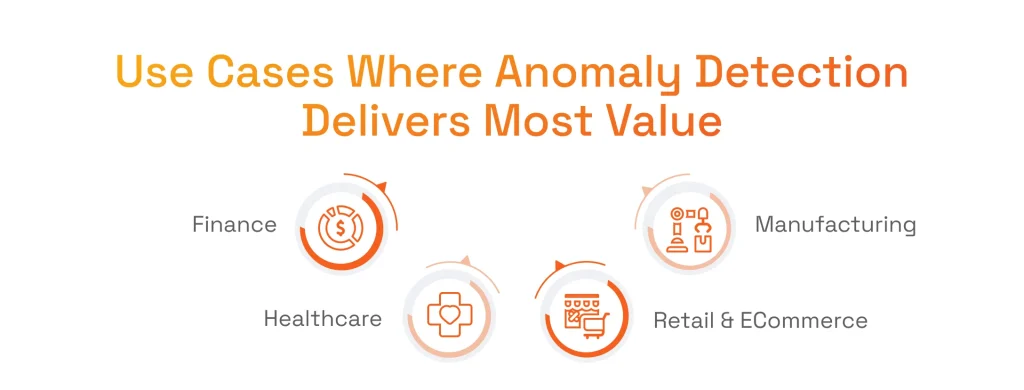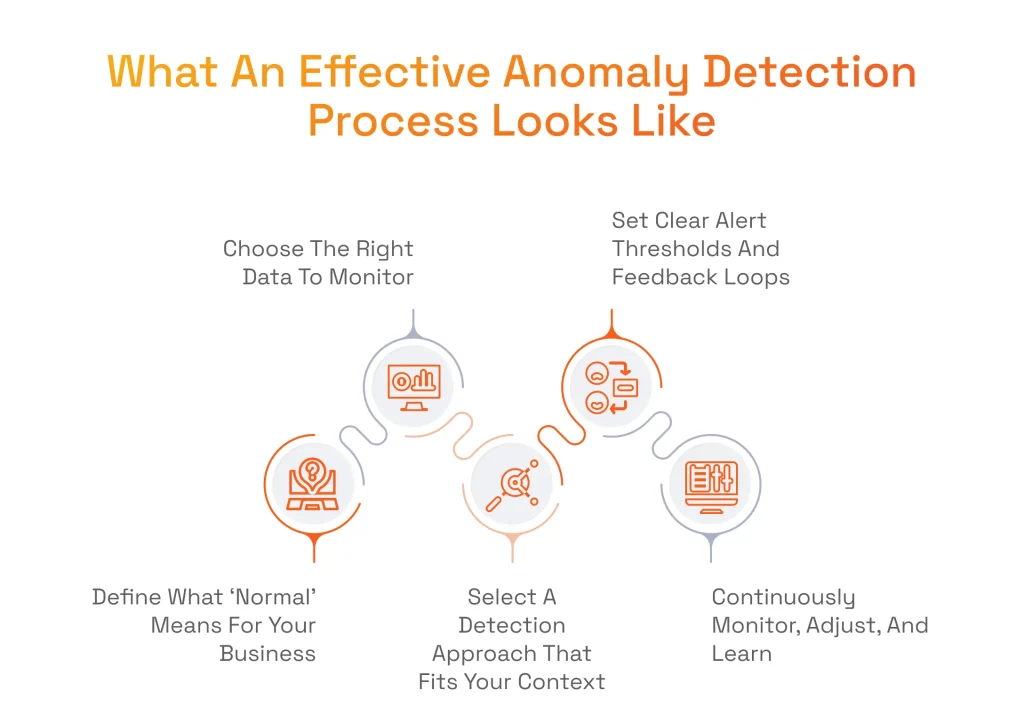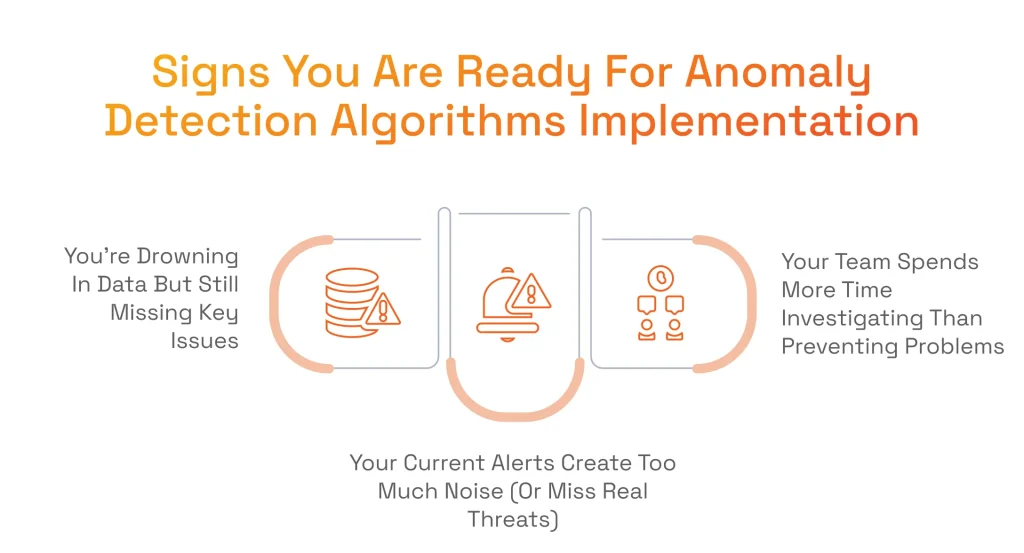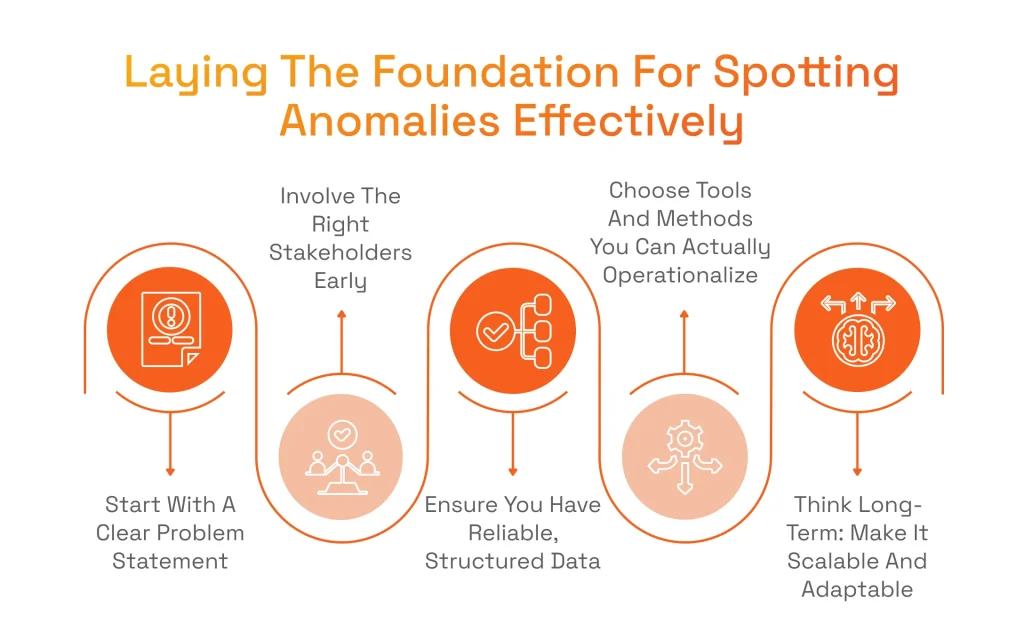Last year, 86% of cyber incidents involved business disruption, spanning from significant operational downtime to massive reputational damage or both, according to research by Palo Alto Networks. Furthermore, 50% of enterprises with distributed data architectures will adopt data observability tools, up from less than 20% in 2024, as reported by Gartner.
In this article, we will focus on anomaly detection with machine learning as a practical, high-impact capability that drives smarter operations and faster decisions. Rather than overwhelming you with math or models, we’ll explore why anomaly detection matters, where it delivers the most value, and how to build an approach that actually fits your organization’s goals.
If you’re considering how to bring intelligent monitoring into your systems, this guide will give you a clear starting point, as well as a path forward with our expert insight.
What Is Anomaly Detection in Machine Learning — and Why It Matters to Your Business
Anomaly detection is the process of identifying data points or patterns that don’t align with expected behavior, as it’s about spotting the unusual before it becomes a serious problem with major consequences. While traditional monitoring systems rely on predefined rules, anomaly detection machine learning algorithms learn what is the “normal” first, and then flag even the slightest signs of potential trouble in real-time. This exceptional capability has already proven itself in powerful applications for many industries.
Fraud detection using machine learning, for example, can already be considered a standard for the finance industry, helping to identify fraudulent transactions the moment they occur. In IT operations, anomaly detection algorithms enable the detection of early indicators of system failure, before they escalate into major outages. As for ecommerce and SaaS platforms, the technology can help to detect sudden shifts in user activity and conversion rates, which can signal bugs or external attacks. Lastly, but not least, the manufacturing industry serves as a remarkable anomaly detection machine learning example where slight deviations in sensor data can indicate failures in costly equipment, and having a powerful modern solution is vital.
Unfortunately, the actual cost of data anomalies exceeds the initial estimates. The damage from fraud can snowball into reputational damage and lost customer trust. Undiagnosed system issues can eventually lead to extended downtime, negatively impacting productivity and revenue. And if KPIs slip without being noticed, it may take weeks before a drop in performance is understood and corrected, during which time your competitors will take the lead.
What Makes a Pattern ‘Anomalous’? (And Why That’s Not Always Obvious)
So, an anomaly is something that deviates from the norm; however, with data, what qualifies as abnormal is not always obvious. Aside from extreme spikes and drops, many anomalies are far more subtle and only make sense when viewed within a specific context. This factor makes machine learning anomaly detection both a powerful and complex process.
There are three main types of anomalies:
- Point anomalies are individual data points that stand out, for example, a single fraudulent transaction.
- Contextual anomalies depend on timing or environment. For instance, a drop in sales might be expected on a weekend but is suspicious midweek.
- Collective anomalies are groups of data points that appear normal individually but are unusual as a whole, like a pattern of user activity that signals a coordinated attack.
It is easy for traditional business intelligence tools to overlook this nuance, as they rely on static thresholds and historical averages, which are insufficient for modern, dynamic environments. There is no surprise here, as BI dashboards are built to report on past events, showing what happened, rather than what is wrong at the moment.
Anomaly detection using machine learning, on the other hand, continually learns from data and easily adapts to changing inputs. This approach takes into account seasonality, context, and relationships between variables, helping teams detect issues before they escalate.
Today, understanding what makes a specific pattern truly anomalous is essential. Spotting every slight deviation from the norm is important, while identifying the most impactful ones is critical. This requires more than a static dashboard, but rather a state-of-the-art intelligent system that can spot what humans and traditional tools often miss.
Find out how we leveraged machine learning algorithms for anomaly detection to help our client.
In this detailed credit card fraud detection case study, we demonstrate the capabilities of trending technology to deliver business results.
3 Approaches to Anomaly Detection Using Machine Learning
There are several types of anomaly detection systems, each with its distinct limitations and strengths. Let’s break them down and discuss why machine learning has become the go-to solution for detecting meaningful deviations in complex datasets.

- Rule-Based Systems: They rely on predefined thresholds and business logic set manually. As an example of a rule, any transaction over $5,000 should be considered suspicious. Rule-based systems are great for predictable and familiar problems, but they don’t scale in dynamic environments. With the growth of the dataset, static rules will most likely fail to keep up and will generate too many false positives or miss emerging threats entirely. To fix this, constant manual updates are required, which add operational overhead.
- Statistical Methods: These methods include techniques like Z-scores, moving averages, and hypothesis testing, which can detect anomalies in structured and relatively stable datasets. While they work reasonably well for detecting outliers in consistent datasets, when seasonality, trends, or multiple correlated variables come into play, statistical methods typically struggle. The model needs to be recalibrated every time data changes.
- Machine Learning Models: Compared to the previous two, machine learning anomaly detection offers a far more flexible and scalable approach. In the context of AI and IoT, some anomaly detection models, including Isolation Forests, Autoencoders, and LSTM networks, can learn normal behavior from historical data, adapt to changing patterns, and identify anomalies without explicit rules and manual input. This is invaluable in high-dimensional, real-time data environments where human monitoring or manual rules would be impractical. Machine learning for anomaly detection is also very good at identifying subtle contextual or collective anomalies that other methods often overlook.
Serhii Leleko
AI & ML Engineer at SPD Technology
“The first two methods have their place. Rule-based systems can work for small-scale and legacy systems, while statistical models can be just enough for monitoring business KPIs. Modern, data-driven organizations, however, should pay attention to the advancements in machine learning for anomaly detection, as ML is perfect for handling large, evolving datasets with agility, precision, and depth.”
Common Use Cases Where Anomaly Detection Algorithms Deliver Most Business Value
According to Precedence Research, the global anomaly detection market is valued at $6.90 billion in 2025, and is expected to reach $28.00 billion by 2034. It is important to note that the machine learning and Artificial Intelligence segment is expected to expand at the highest CAGR of 18.92% during this period, as the number of real-world applications of anomaly detection in machine learning will increase dramatically.

Finance
Anomaly detection is a significant part of ML in finance, helping to provide exceptional fraud detection, compliance, and risk management. ML algorithms for anomaly detection easily flag suspicious transactions, abnormal trading behavior, or data breaches in milliseconds, which is far superior to manual reviews. Additionally, the ML in fintech development services offers a big help in detecting internal and system errors that could lead to regulatory violations.
Healthcare
Proper implementation of machine learning in healthcare can save lives, as anomalies here influence vital decisions. Use cases include monitoring patient vitals, lab results, and device readings to detect early signs of deterioration or malfunction. Anomaly detection machine learning also allows for the identification of scheduling irregularities, billing errors, or unusual treatment patterns that may signal administrative or systemic issues.
Retail & eCommerce
The integration of machine learning in retail for anomaly detection boosts customer experience and secures revenue. ML models can easily detect suspicious drops in conversion rates, spikes in cart abandonment, or fraudulent user behavior much faster compared to human experts. There is also ML-powered predictive analytics for consumer behavior that allows for managing inventory most effectively, flagging changes in demand to adjust supply chains on time.
Manufacturing
Machine learning in the manufacturing industry is all about preventing costly downtime and breakdown of expensive equipment and machinery. By analyzing sensor data, algorithms can detect subtle shifts in temperature, vibration, or output quality that suggest a failure is near. This minimizes disruptions, reduces repair costs, and extends equipment life.
Delve deep into predictive maintenance with machine learning by reading our featured article.
It covers key aspects of this process, supported by practical insights from our experts.
What an Effective Anomaly Detection Process Looks Like
Whatever type of anomaly detection algorithm you will end up using, you must remember that there is no magic here, but rather a thought-out, systematic process. So, whether you’re tracking an industrial system’s performance or applying credit card fraud detection with ML, here is the process to follow.

1. Define What ‘Normal’ Means for Your Business
It makes sense to start with defining a baseline. What does typical behavior look like for your users, transactions, systems, or machines? Set a reference point for detecting deviations. For instance, website traffic for your organization may dip on weekends, which is considered normal. However, a sudden drop on Monday likely indicates some problems.
2. Choose the Right Data to Monitor
Focus on data streams that have the most significant impact, particularly those tied to core organizational metrics such as revenue, system uptime, or customer experience. Clean and high-quality data is essential for unsupervised anomaly detection and semi-supervised anomaly detection, or any ML solution in general. It is impossible to effectively operate based on incomplete or noisy data, as it increases false positives and reduces the effectiveness of ML models.
3. Select a Detection Approach That Fits Your Context
As discussed previously, for predictable environments like fixed KPIs and controlled manufacturing lines, statistical and rule-based methods will work just fine. For large-scale systems where parameters, such as user behavior, financial activity, or sensor readings, are constantly changing, machine learning models offer better adaptability and precision.
4. Set Clear Alert Thresholds and Feedback Loops
Alerts must trigger meaningful, predefined actions. Oversight of dedicated development teams is crucial, especially in the early stages, to validate anomalies and fine-tune detection logic. Feedback loops help refine the system, so it learns from false positives and missed issues over time.
5. Continuously Monitor, Adjust, and Learn
Anomaly detection fraud detection, or any other use case, requires much more than a one-time setup. It is essential to constantly monitor data for drift and seasonal changes to be able to retrain models, adjusting to new behaviors. An effective anomaly detection process should evolve alongside your business and improve with each iteration.
Signs You Are Ready for Anomany Detection Algorithms Implementation
When your organization is collecting more data than ever before, but still struggling to derive valuable insights, it may be time to rethink your monitoring approach. It is common for organizations to reach a point where traditional tools can no longer keep up, leading to missed threats, wasted effort, and growing operational risk.

Another key sign is alert fatigue, when your existing systems flag too many false positives or fail to detect issues until it’s too late. As data volumes continue to grow, slow response times will eventually lead to critical blind spots.
When alerts become a noise, your technical team will spend more time reacting than proactively solving problems. Suppose your experts spend hours investigating what went wrong instead of preventing it in the first place. In that case, that’s another red flag signaling the need for a modern anomaly detection in machine learning solution. Lacking innovative, adaptive tools makes it nearly impossible to spot subtle patterns or emerging risks in time.
Laying the Foundation for Spotting Anomalies Effectively
Did you realize you have a data problem, and recognized your business in the previous section? Here are the most important preparatory steps for an effective anomaly detection solution implementation.

Start with a Clear Problem Statement
It all starts with clarity, not fancy algorithms. You already know some algorithms, or even popular tools, but take a step back and define what exactly you are trying to detect. Is it fraud? Latency spikes? Unexpected shifts in user behavior or failures in a data pipeline? A clear problem statement not only sharpens your detection goals but also helps you measure success and choose the right approach, as some work better than others.
Involve the Right Stakeholders Early
Anomalies cross technical and operational boundaries, so your process should do it too. Combine domain experts from finance, operations, or product with your data analysts and engineers. This cross-functional collaboration reduces blind spots and ensures that what counts as “anomalous” is dealt with on the business level as well.
Ensure You Have Reliable, Structured Data
Data assessment is critical, as ML-powered anomaly detection is only as good as the data behind it. Make sure that your primary data sources are reliable and structured, as well as labeled. Investing in data hygiene early on saves time and improves accuracy down the line.
Choose Tools and Methods You Can Actually Operationalize
Start simple while selecting tools and methods, focusing on what your team can operationalize. Highly advanced and sophisticated tools are good, but they are useless when they are too complex for maintenance. Focus on the technology that delivers fast wins and easy adoption.
Think Long-Term: Make It Scalable and Adaptable
Finally, always have the future in mind. Your detection process should scale with your data and seamlessly adapt to changing patterns over time. This long-term mindset helps you avoid costly redesigns and ensures your system continues to add value as your business grows.
Serhii Leleko
AI & ML Engineer at SPD Technology
“The most important thing to remember is that effective anomaly detection solutions are not plug-and-play, but rather a capability you build for the long run. Find a professional team with proven experience that will be capable of laying the groundwork for your system to grow smarter and more accurate over time.”
Conclusion
Anomaly detection algorithms can dramatically improve core elements of businesses, as they serve as a transformative tool for detecting hidden issues, preventing fraud, and maintaining the integrity of systems. Winning organizations are already leveraging custom AI solutions built on classic models like Isolation Forest and One-Class SVM or advanced deep learning techniques and the capabilities of LLMs, which allow them to detect and respond to anomalies with precision like never before.
Whether you have a goal to secure your infrastructure, monitor customer behavior, or improve operational efficiency, effective anomaly detection can be a game-changer. Here at SPD Technology, with our profound experience in AI and IoT, we know how to implement and scale real-time anomaly detection solutions of any complexity. Feel free to contact us anytime, and we will be happy to support your journey toward smarter, safer, and more reliable systems.
FAQ
Which model is best for anomaly detection?
The best choice of an ML-based anomaly detection model depends on the use case and the type of data. Isolation Forest, One-Class SVM, and Autoencoders are considered excellent choices for tabular data. For time series, LSTM-based models or Prophet are effective. For complex and high-dimensional data, such as logs and transactions, it is sensible to utilize Variational Autoencoders (VAEs) and Transformer-based architectures.
How is anomaly detection used in Large Language Models (LLMs)?
LLMs leverage anomaly detection to detect unusual patterns in language, behavior, or input-output relationships. The most common use cases include detecting hallucinations in generated text, identifying prompt injection attacks, and recognizing deviations in chatbot behavior.
How is anomaly detection different from outlier detection?
Anomaly detection methods are all about finding data points that significantly deviate from expected behavior. Outlier detection, on the other hand, identifies extreme values in a dataset without necessarily considering time or context. All anomalies are outliers, but not all outliers are anomalies.

